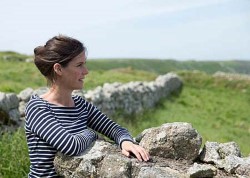 Monday night was discussion evening at the pop-up exhibition at the Sir John Soane's Museum in London about Astley Castle. We wandered round the gallery where exploded models and huge blown up images of Astley Castle were shown, before inspecting pieces from Sir John Soane’s own collection - among them a host of ravishing paintings and drawings of sublime landscapes speckled with Classical ruins.
Monday night was discussion evening at the pop-up exhibition at the Sir John Soane's Museum in London about Astley Castle. We wandered round the gallery where exploded models and huge blown up images of Astley Castle were shown, before inspecting pieces from Sir John Soane’s own collection - among them a host of ravishing paintings and drawings of sublime landscapes speckled with Classical ruins.
As we walked there was debate about whether or not ruined buildings ‘should’ be reused. Some felt that ruins, like the broken statue of an emperor in Shelley’s Ozymandius, are an expression of how fleeting human ambition is and something that in their decay have a melancholy loveliness. Others argued that to take pleasure from a ruin is like preferring a corpse to a living person; buildings should be used and to delight in their destruction is absurd.
While Landmark absolutely stands for living buildings, and has perhaps rescued more than any other body in Britain, even we don’t think all ruins should be restored. Some, like the shattered skeleton of the great Cistercian house of Rievaulx Abbey in Yorkshire are excoriating expressions of the great destructions of our past. The epic ‘World at War’ series begins with the camera wandering through the village of Oradour-sur-Glane in France to Laurence Oliver’s laconic narration, a place deliberately left unrestored as a memorial to the past.
For every age ruins have held different associations. In the early Middle Ages many in England lived in the ragged remnants of Roman Britain, the abandoned cities and crumbling legionary forts. The Anglo-Saxon poem ‘The Ruin’ is a lament for a lost past. In the late 18th century, influenced by images of Classical ruins in dream landscapes, ruins became all the rage. Fake ruins, like our own at Hackfall, were built as ornaments and many perfectly good old buildings like John of Gaunt’s great hall at Kenilworth Castle were deliberately smashed up to look more romantic. In the 20th century ruination for many was a real and recent image of war, and the immaculate lawns returning soldiers helped create round the Ministry of Works abbeys were a generation’s way of reclaiming the ruin, as the poppies did the Flanders mud.
In truth, though, a real ruin is not romantic but frightening. It is not found in the cricket pitch surroundings of Rievaulx, our restrained re-inhabitation of Astley Castle or the artificial crumbling at Hackfall. Real ruins are dangerous and hostile. They are not visited but climbed or broken into, their atmosphere is not calm but threatening, and their walls seep with the violence they have seen. I asked Lord Daventry, who owns the Arbury estate, about his boyhood memories of Astley Castle. He spoke not of the beauty of the building in its landscape, but of the horror of going into the burnt-out shell and the overwhelming and unbearable stench of destruction. In real ruination there is no beauty.
Anna Keay